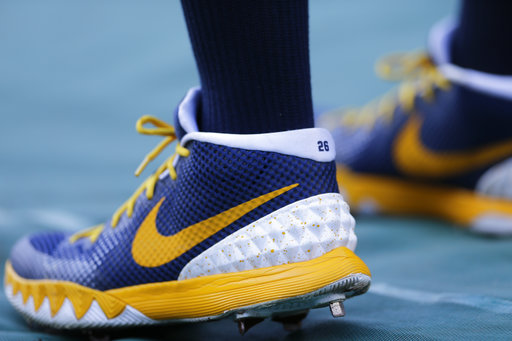
Property marketer Lobo Zhang joined a gym for the first time last year, adding to his collection of trainers and helping Chinese sportswear sales to climb at twice the rate of clothing and footwear in general. Sample the FT’s top stories for a week You select the topic, we deliver the news. Select topic Enter email addressInvalid email Sign up By signing up you confirm that you have read and agree to the terms and conditions, cookie policy and privacy policy. China is in the grip of a government-backed exercise boom, boosting local sportswear brands and the likes of Adidas and Nike, which are gaining market share on the back of consumer upgrading and an embrace of the “athleisure” fashion trend. Adidas this month said its sales in greater China rose 28 per cent last year — the fastest pace of any region, adding to net global profit growth of more than 60 per cent, while Nike reported “double-digit” sales growth in China in its most recent quarter. Greater China is the second-largest market for both brands, which together account for about a third of the country’s sportswear sales. The country’s importance to Nike was highlighted last week when it expressed “severe regret” after state-broadcaster CCTV reported it had inaccurately advertised some of its shoes — although only 300 pairs were implicated. Sportswear sales in China rose 11 per cent last year to Rmb187bn ($27bn), according to consultancy Euromonitor. By contrast, sales of overall apparel climbed just 5 per cent. Analysts say that Nike, Adidas and New Balance, which command higher prices than local brands, are viewed by Chinese consumers more as fashion labels than sportswear. “Global brands are still very strong in shaping fashion trends especially in the female market,” says Spencer Leung, an analyst at UBS. Their sales growth stems from consumers upgrading as incomes rise, as well as the growing acceptance of sportswear in leisure and work settings. General fashion companies are feeling the shift. Belle International Holdings, the country’s second-largest footwear company by sales, said its 2016 shoe sales slid 9 per cent year on year, while trainers revenue jumped 16 per cent. “Athleisure is the only footwear type that bucks the trend,” says Sheng Baijiao, Belle chairman, adding that people increasingly dress down in the office. Local brands, still widely perceived as copying design innovations from overseas, are also benefiting, with their sales increasing rapidly as more Chinese take up exercise. Gym membership in the country has doubled since 2008 to 6.6m last year, according to the China Business Research Academy. Running has become a popular pastime, with more than 100 marathons held last year compared with 51 in 2014. Yoga practitioners are estimated to have grown from 4m in 2009 to more than 10m today. Fun run: more than 100 marathons were held last year in China compared with 51 in 2014 © AFP The ruling Communist party has also boosted the uptake of sports. Facing an epidemic of obesity-related diabetes and other lifestyle-associated illnesses, China’s government has pledged that the number of football pitches across the country will rise from roughly 50,000 to 70,000 by 2020 — by which time it aims to have increased sports venue area per capita from 1.6 to 1.8 square metres. “People themselves are getting into exercise, so government initiatives are really helping the trend to accelerate,” says Matthew Crabbe, analyst at Mintel, the research group. Analysts say the fitness phenomenon is of greater benefit to mid-market local brands, as consumers favour value and functionality over fashion statements when exercising. Mr Zhang says he purchased jogging pants and T-shirts from Anta — a mid-priced label that is China’s third most popular — along with a gym membership. Anta said last month its 2016 net profit jumped 17 per cent year on year to a record high of Rmb2.4bn ($347m). Operating profit margins for the year stood at 24 per cent, compared with roughly 14 per cent for Nike and 8 per cent for Adidas. The company received publicity from sponsoring China’s 2016 Olympic team, and a revenue boost from sales of the higher-prestige Italian Fila brand, whose Chinese distribution rights it acquired in 2009. Even as the market expands, margins are under pressure from the rise of ecommerce in China, a boon for consumers that has pushed brands to cut prices in the face of more transparent competition. “In the past year you have seen prices that are quite low . . . international brands do markdowns quickly,” says Chen Ke, a partner at Roland Berger. The relative losers in this spate of upgrading and exercising will be the lowest-end Chinese brands, Mr Chen says. He expects annual growth of less than 3 per cent for these groups, compared with overall market growth of 8 per cent, over the next five years. Future momentum for Nike and Adidas sales could also be dented by competition from niche upstarts such as Under Armour, which achieved revenues of roughly $180m in China last year. Lululemon, the Canadian yoga brand, is catching on among wealthy urbanites and has opened stores in Beijing and Shanghai. “The upper end, not necessarily more expensive but more unique companies targeting millennials are the ones growing faster,” says Weiwen Han, partner at Bain.
Article Retrieved from
https://www.ft.com/content/ea7ca9ac-040f-11e7-ace0-1ce02ef0def9
Photo Retrieved from
http://www.taiwannews.com.tw/ch/news/3124747